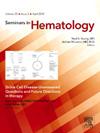弥漫大b细胞淋巴瘤(DLBCL)的流行病学及病因学分析
IF 5
3区 医学
Q1 HEMATOLOGY
引用次数: 0
摘要
弥漫性大b细胞淋巴瘤(DLBCL)是最常见的非霍奇金淋巴瘤亚型,其发病模式与NHL总体相似。在全球范围内,DLBCL占所有nhl的三分之一,按国家划分在20%-50%之间。根据美国癌症登记数据,DLBCL的年龄标准化发病率为每10万人7.2例。DLBCL的发病率随着年龄的增长而上升,通常男性高于女性;在美国,非西班牙裔白人的发病率最高(每10万人中有9.2人)。与NHL发病率一样,DLBCL发病率在20世纪上半叶有所上升,但在很大程度上已趋于平稳。然而,有一些证据表明,在历史上发病率较低的地区,如亚洲,发病率正在上升;据估计,在不久的将来,由于发达国家人口结构的变化,人口老龄化正在加剧,DLBCL的发病率将会上升。DLBCL的已知危险因素包括导致严重免疫缺陷的因素,如艾滋病毒/艾滋病、遗传性免疫缺陷综合征和器官移植受者。导致慢性免疫失调的因素也是确定的危险因素,包括许多自身免疫性疾病(例如Sjögren综合征、系统性红斑狼疮、类风湿性关节炎)、病毒感染(例如HIV、KSHV/HHV8、HCV、EBV)和肥胖。NHL/DLBCL家族史、个人癌症史和多个遗传易感位点也是DLBCL的危险因素。有强有力的证据表明,多种环境暴露是DLBCL的病因,包括暴露于三氯乙烯、苯、杀虫剂和除草剂,最近发现与草甘膦有关。也有强有力的证据表明它与其他病毒,如乙肝病毒有关联。最近的估计表明,肥胖占发生的DLBCL的近四分之一,但是尽管最近对DLBCL病因的了解有所增加,但大多数疾病仍然无法解释。了解宿主和环境对疾病病因的影响,并共同努力将我们的理解扩展到多种族/民族群体,对于构建临床相关的风险预测模型和制定有效的疾病预防策略至关重要。本文章由计算机程序翻译,如有差异,请以英文原文为准。
Epidemiology and etiology of diffuse large B-cell lymphoma
As the most common non-Hodgkin lymphoma subtype, diffuse large B-cell lymphoma (DLBCL) incidence patterns generally parallel that for NHL overall. Globally, DLBCL accounts for a third of all NHLs, ranging between 20% and 50% by country. Based on United States (U.S.) cancer registry data, age-standardized incidence rate for DLBCL was 7.2 per 100,000. DLBCL incidence rises with age and is generally higher in males than females; in the U.S., incidence is highest among non-Hispanic whites (9.2/100,000). Like NHL incidence, DLBCL incidence rose in the first half of the 20th century but has largely plateaued. However, there is some evidence that incidence rates are rising in areas of historically low rates, such as Asia; there are also estimates for rising DLBCL incidence in the near future due to the changing demographics in developed countries whose aging population is growing. Established risk factors for DLBCL include those that result in severe immune deficiency such as HIV/AIDS, inherited immunodeficiency syndromes, and organ transplant recipients. Factors that lead to chronic immune dysregulations are also established risk factors, and include a number of autoimmune conditions (eg, Sjögren syndrome, systemic lupus erythematosus, rheumatoid arthritis), viral infections (eg, HIV, KSHV/HHV8, HCV, EBV), and obesity. Family history of NHL/DLBCL, personal history of cancer, and multiple genetic susceptibility loci are also well-established risk factors for DLBCL. There is strong evidence for multiple environmental exposures in DLBCL etiology, including exposure to trichloroethylene, benzene, and pesticides and herbicides, with recent associations noted with glyphosate. There is also strong evidence for associations with other viruses, such as HBV. Recent estimates suggest that obesity accounts for nearly a quarter of DLBCLs that develop, but despite recent gains in the understanding of DLBCL etiology, the majority of disease remain unexplained. An understanding of the host and environmental contributions to disease etiology, and concerted efforts to expand our understanding to multiple race/ethnic groups, will be essential for constructing clinically relevant risk prediction models and develop effective strategies for disease prevention.
求助全文
通过发布文献求助,成功后即可免费获取论文全文。
去求助
来源期刊

Seminars in hematology
医学-血液学
CiteScore
6.20
自引率
2.80%
发文量
30
审稿时长
35 days
期刊介绍:
Seminars in Hematology aims to present subjects of current importance in clinical hematology, including related areas of oncology, hematopathology, and blood banking. The journal''s unique issue structure allows for a multi-faceted overview of a single topic via a curated selection of review articles, while also offering a variety of articles that present dynamic and front-line material immediately influencing the field. Seminars in Hematology is devoted to making the important and current work accessible, comprehensible, and valuable to the practicing physician, young investigator, clinical practitioners, and internists/paediatricians with strong interests in blood diseases. Seminars in Hematology publishes original research, reviews, short communications and mini- reviews.
 求助内容:
求助内容: 应助结果提醒方式:
应助结果提醒方式:


